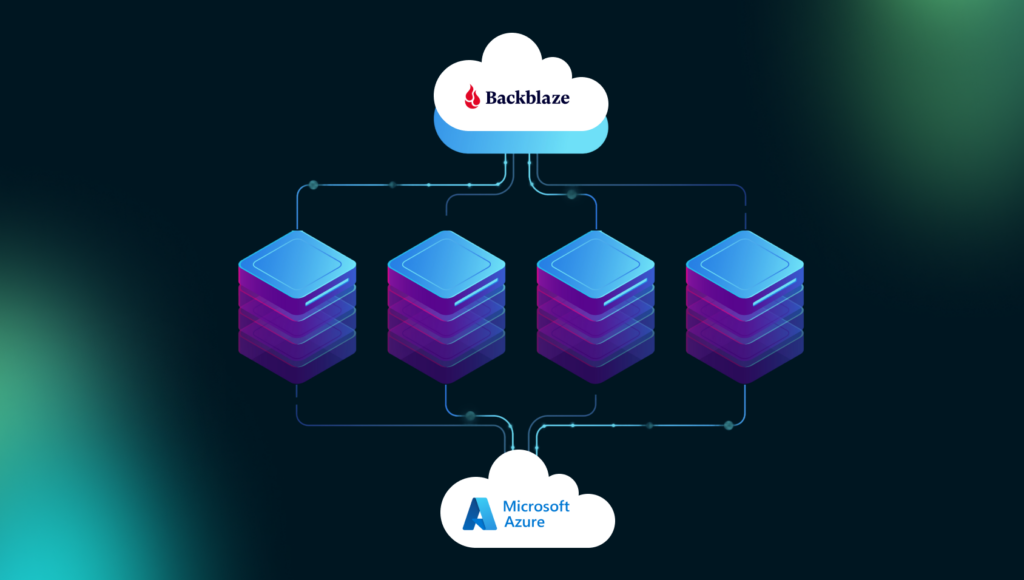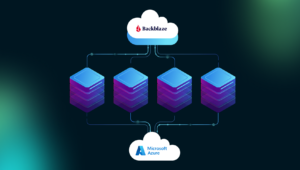
Understanding S3 Compatibility
Backblaze B2 Cloud Storage implements a robust S3-compatible API, allowing you to use familiar S3 tools and SDKs with minimal changes. This means if your applications or workflows are already built for Amazon S3, they can often work with Backblaze B2 by simply changing endpoint URLs and credentials. Backblaze B2’s S3 compatibility extends to most common S3 operations, making it easy to integrate with backup solutions, migration tools, and data management utilities.
Azure Blob Storage, on the other hand, does not natively support the S3 API. However, you can achieve S3 compatibility using an S3-to-Azure gateway such as Flexify.IO or open-source projects like S3Proxy. These gateways translate S3 API calls into Azure Blob Storage operations, enabling S3-based tools to interact with Azure storage.

Typical Integration Workflow
1- Moving Data from Azure to Backblaze B2
- Export Data to Azure Blob Storage: Start by ensuring your data is in Azure Blob Storage, which is the standard object storage service in Azure.
- Use a Migration Tool: Tools like AzCopy, CloudBerry Backup, or Veeam can move data from Azure Blob Storage to Backblaze B2. These tools often support both Azure and S3-compatible endpoints, making the transfer straightforward.
- Configure Backblaze B2 as an S3 Endpoint: In your tool of choice, set Backblaze B2’s S3 endpoint (e.g., s3.us-west-000.backblazeb2.com), along with your application key and secret.
2- Making Azure Blob Storage S3-Compatible
- Deploy an S3 Gateway: Use Flexify.IO or S3Proxy to expose your Azure Blob Storage as an S3-compatible endpoint. This allows S3-based applications to read and write data to Azure as if it were an S3 bucket.
- Connect Your Applications: Point your S3-compatible tools or scripts to the gateway’s endpoint, using the credentials mapped to your Azure storage account.
Benefits of S3 Compatibility
- Tool Reuse: Use existing S3-compatible backup, migration, and management tools with minimal changes.
- Cost Optimization: Store infrequently accessed or archival data in Backblaze B2, which offers significantly lower pricing than Azure Blob Storage.
- Redundancy: Maintain copies of critical data across both Azure and Backblaze for disaster recovery and compliance.
Sample Use Case: Backing Up Azure VMs to Backblaze B2
- Back up Azure VMs to Azure Blob Storage using Azure Backup.
- Transfer the backups to Backblaze B2 using a tool like AzCopy or Veeam, configured with Backblaze’s S3-compatible endpoint and credentials.
- Automate the process for ongoing redundancy and cost savings.
Key Considerations
- API Differences: While Backblaze B2’s S3-compatible API closely mirrors AWS S3, there are some differences in endpoints and access control lists (ACLs). Always review the documentation when designing your workflow.
- Gateway Performance: The performance of S3-to-Azure gateways can vary. Flexify.IO is noted for its speed and is available via Azure Marketplace or Docker Hub.
Further Reading and Resources
- Backblaze B2 Cloud Storage Overview
- Backblaze S3-Compatible API Documentation
- Azure Blob Storage and S3 API Support Discussion
- How to Backup Microsoft 365 Data to Backblaze B2
- Backing Up Azure VMs to S3 Providers
In summary:
While Azure Blob Storage doesn’t natively support S3 APIs, you can enable S3 compatibility through gateways, making it possible to use S3-based tools to move data between Azure and Backblaze B2. This approach unlocks cost savings, flexibility, and enhanced data protection for modern cloud workflows.
Related Articles (Sources):







